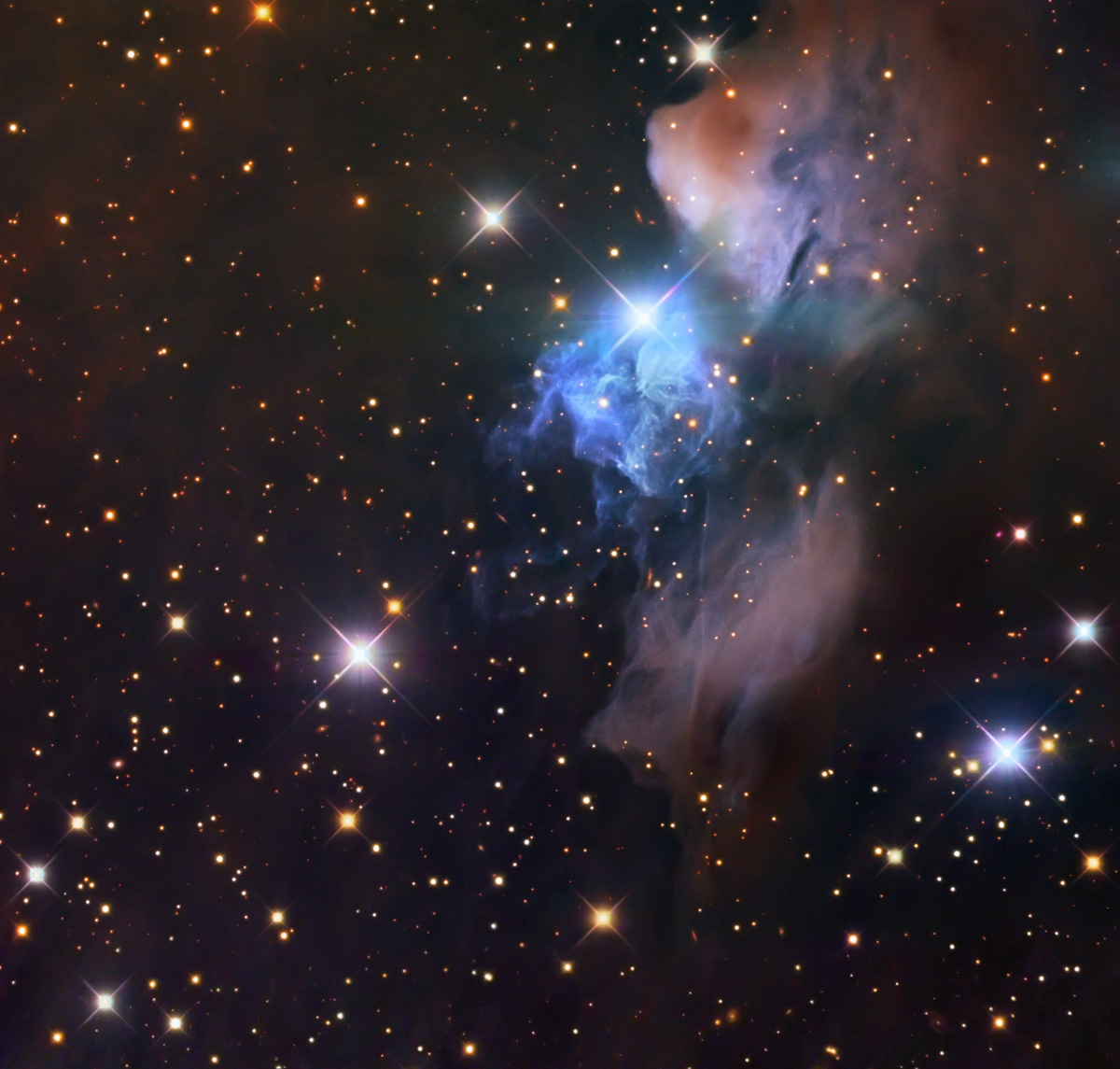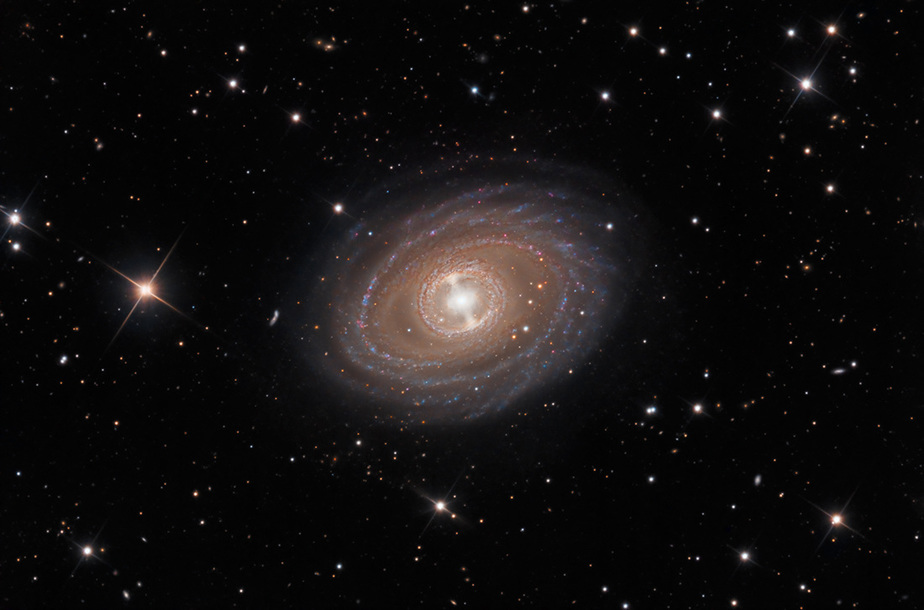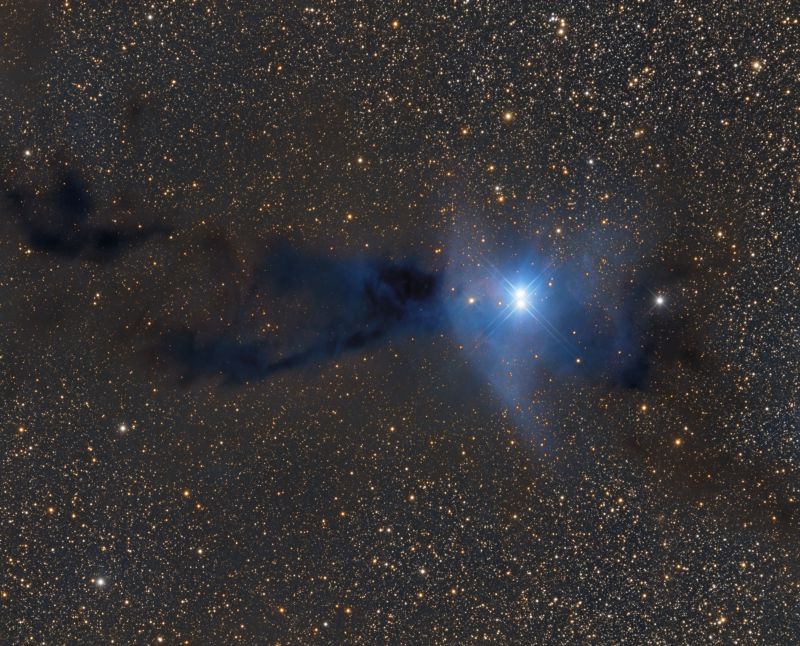Found Images: 2015 July
Found Images: 2015 July
Have you seen a great image or video somewhere that you think would make a great APOD? Nominate it for APOD! Please post as much information here as you have about the image/video with a link to any source(s) for it you know of here, and the editors will take a look.
When posting the image itself, please do not post anything larger than a thumbnail here; please honor the copyright holder's copyright.
Please keep hotlinked images under 400K.
Thank you!
-
starsurfer
- Stellar Cartographer
- Posts: 5335
- Joined: Thu Mar 15, 2012 7:25 pm
Re: Found Images: 2015 July
Orion Nebula (M42)
http://www.chart32.de/index.php/component/k2/item/107
Copyright: CHART32
Processing: Johannes Schedler
http://www.chart32.de/index.php/component/k2/item/107
Copyright: CHART32
Processing: Johannes Schedler
-
starsurfer
- Stellar Cartographer
- Posts: 5335
- Joined: Thu Mar 15, 2012 7:25 pm
Re: Found Images: 2015 July
Horsehead Nebula (B33) widefield
http://www.glitteringlights.com/Images/ ... drNZv2T/X3
Copyright: Marco Lorenzi
http://www.glitteringlights.com/Images/ ... drNZv2T/X3
Copyright: Marco Lorenzi
-
starsurfer
- Stellar Cartographer
- Posts: 5335
- Joined: Thu Mar 15, 2012 7:25 pm
Re: Found Images: 2015 July
Seagull Nebula (IC 2177)
http://www.robgendlerastropics.com/IC21 ... ubaru.html
Copyright: Robert Gendler
http://www.robgendlerastropics.com/IC21 ... ubaru.html
Copyright: Robert Gendler
-
starsurfer
- Stellar Cartographer
- Posts: 5335
- Joined: Thu Mar 15, 2012 7:25 pm
Re: Found Images: 2015 July
vdB24
http://www.capella-observatory.com/Imag ... /vdB24.htm
Copyright: Makis Palaiologou, Stefan Binnewies and Josef Pöpsel
http://www.capella-observatory.com/Imag ... /vdB24.htm
Copyright: Makis Palaiologou, Stefan Binnewies and Josef Pöpsel
-
starsurfer
- Stellar Cartographer
- Posts: 5335
- Joined: Thu Mar 15, 2012 7:25 pm
-
starsurfer
- Stellar Cartographer
- Posts: 5335
- Joined: Thu Mar 15, 2012 7:25 pm
ESO: Stars Circle La Silla
Stars Circle La Silla
ESO Picture of the Week | 2015 Jul 06
ESO Picture of the Week | 2015 Jul 06
This image by ESO Photo Ambassador Alexandre Santerne shows the Swedish–ESO Submillimetre Telescope (SEST) on the left, alongside the ESO 3.6-metre telescope on the right. In the background bright star trails circle the La Silla Observatory where the telescopes are situated, in the outskirts of the Atacama Desert in Chile.
Star trails like these are created by using a long exposure to capture the apparent motion of the stars in the night sky as the Earth rotates. This image is a composite of 250 consecutive one-minute exposures, spanning four hours. A flipped version of the star trails is also visible as a reflection in the dish of the telescope. The reflection also includes the red lights of a car passing by.
La Silla is ESO’s first observatory and has been a major ESO stronghold since the 1960s. SEST was, at the time of construction, the only large submillimetre telescope in the southern hemisphere. Since it was decommissioned in 2003 SEST has been superseded by other submillimetre telescopes such as the Atacama Pathfinder Experiment telescope and the Atacama Large Millimeter/submillimeter Array, both located on Chile’s Chajnantor Plateau.
The ESO 3.6-metre telescope is host to HARPS, the High Accuracy Radial velocity Planet Searcher — the world's foremost exoplanet hunter.
Know the quiet place within your heart and touch the rainbow of possibility; be
alive to the gentle breeze of communication, and please stop being such a jerk. — Garrison Keillor
alive to the gentle breeze of communication, and please stop being such a jerk. — Garrison Keillor
HEIC: Galaxy with a View (LEDA 89996)
Galaxy with a View
ESA Hubble Picture of the Week | 2015 Jul 06
ESA Hubble Picture of the Week | 2015 Jul 06
[img3="Credit: NASA/ESA/Hubble (ACS)"]http://cdn.spacetelescope.org/archives/ ... w1527a.jpg[/img3][hr][/hr]This little-known galaxy, officially named J04542829-6625280, but most often referred to as LEDA 89996, is a classic example of a spiral galaxy. The galaxy is much like our own galaxy, the Milky Way. The disc-shaped galaxy is seen face on, revealing the winding structure of the spiral arms. Dark patches in these spiral arms are in fact dust and gas — the raw materials for new stars. The many young stars that form in these regions make the spiral arms appear bright and bluish.
The galaxy sits in a vibrant area of the night sky within the constellation of Dorado (The Swordfish), and appears very close to the Large Magellanic Cloud — one of the satellite galaxies of the Milky Way.
The observations were carried out with the high resolution channel of Hubble’s Advanced Camera for Surveys. This instrument has delivered some of the sharpest views of the Universe so far achieved by mankind. This image covers only a tiny patch of sky — about the size of a one cent euro coin held 100 metres away!
Know the quiet place within your heart and touch the rainbow of possibility; be
alive to the gentle breeze of communication, and please stop being such a jerk. — Garrison Keillor
alive to the gentle breeze of communication, and please stop being such a jerk. — Garrison Keillor
-
starsurfer
- Stellar Cartographer
- Posts: 5335
- Joined: Thu Mar 15, 2012 7:25 pm
Re: Found Images: 2015 July
-
starsurfer
- Stellar Cartographer
- Posts: 5335
- Joined: Thu Mar 15, 2012 7:25 pm
Re: Found Images: 2015 July
RCW 32 and RCW 27
http://www.tvdavisastropics.com/astroim ... 000021.htm
Copyright: Thomas Davis Somewhere in the image the planetary nebula Hen 2-11 can be found!
http://www.tvdavisastropics.com/astroim ... 000021.htm
Copyright: Thomas Davis Somewhere in the image the planetary nebula Hen 2-11 can be found!
HEIC: A Galaxy in Bloom (ESO 381-12)
A Galaxy in Bloom (ESO 381-12)
ESA Hubble Photo Release | 2015 July 09
ESA Hubble Photo Release | 2015 July 09
[img3="Credit: NASA, ESA, P. Goudfrooij (STScI)"]http://cdn.spacetelescope.org/archives/ ... c1516a.jpg[/img3][hr][/hr]The ghostly shells of galaxy ESO 381-12 are captured here in a new image from the NASA/ESA Hubble Space Telescope, set against a backdrop of distant galaxies. The strikingly uneven structure and the clusters of stars that orbit around the galaxy suggest that ESO 381-12 may have been part of a dramatic collision sometime in its relatively recent past.
Located roughly 270 million light-years from Earth in the constellation of Centaurus (The Centaur), a bright constellation in the southern sky, ESO 381-12, also known as PGC 42871, is categorised as a lenticular galaxy — a hybrid galaxy type that shares properties with both spiral galaxies and elliptical galaxies.
The delicate shells that bloom outwards from ESO 381-12 are very rarely found around this type of galaxy and their cause is a bit of a cosmic mystery. It is thought that PGC 42871 may have recently interacted with another galaxy, sending shock waves through its structure much like ripples in a pond. These galactic mergers are violent processes, smashing together material within the clashing galaxies and completely changing how they look and how they will evolve in the future. This violent event likely triggered a wave of star formation throughout the galaxy, leading to the creation of many hot young stars.
Astronomers have studied ESO 381-12 in detail because of its very unusual structure. It was one of a sample of galaxies explored by Hubble’s Advanced Camera for Surveys during a recent study of the properties of shell galaxies created in merger events a billion or so years ago.
The prominent galaxy at the right of the frame, known as ESO 381-13 or PGC 42877, is a different beast altogether and both active star formation and dust can be seen within it. However, ESO 381-13 and the shell galaxy are at very similar distances from Earth and, despite their differences, may well be interacting.
Know the quiet place within your heart and touch the rainbow of possibility; be
alive to the gentle breeze of communication, and please stop being such a jerk. — Garrison Keillor
alive to the gentle breeze of communication, and please stop being such a jerk. — Garrison Keillor
-
starsurfer
- Stellar Cartographer
- Posts: 5335
- Joined: Thu Mar 15, 2012 7:25 pm
Re: Found Images: 2015 July
-
starsurfer
- Stellar Cartographer
- Posts: 5335
- Joined: Thu Mar 15, 2012 7:25 pm
Re: Found Images: 2015 July
NGC 3486
http://www.caelumobservatory.com/gallery/n3486.shtml
Copyright: Adam Block
Acknowledgement: R. Jay GaBany
http://www.caelumobservatory.com/gallery/n3486.shtml
Copyright: Adam Block
Acknowledgement: R. Jay GaBany
-
starsurfer
- Stellar Cartographer
- Posts: 5335
- Joined: Thu Mar 15, 2012 7:25 pm
Charon’s Chasms and Craters
Charon’s Chasms and Craters
NASA | JHU-APL | SwRI | New Horizons | 2015 Jul 12
NASA | JHU-APL | SwRI | New Horizons | 2015 Jul 12
[img3="Chasms, craters, and a dark north polar region are revealed in this image of Pluto’s largest moon Charon taken by New Horizons on July 11, 2015. The annotated version includes a diagram showing Charon’s north pole, equator, and central meridian, with the features highlighted. Credits: NASA/JHU-APL/SwRI"]http://www.nasa.gov/sites/default/files ... otated.jpg[/img3][hr][/hr]New Horizons’ newest images reveal Pluto’s largest moon Charon to be a world of chasms and craters. The most pronounced chasm, which lies in the southern hemisphere, is longer and miles deeper than Earth’s Grand Canyon, according to William McKinnon, deputy lead scientist with New Horizon’s Geology and Geophysics investigation team.
“This is the first clear evidence of faulting and surface disruption on Charon,” says McKinnon, who is based at the Washington University in St. Louis. “New Horizons has transformed our view of this distant moon from a nearly featureless ball of ice to a world displaying all kinds of geologic activity.”
The most prominent crater, which lies near the south pole of Charon in an image taken July 11 and radioed to Earth today, is about 60 miles (96.5 kilometers) across. The brightness of the rays of material blasted out of the crater suggest it formed relatively recently in geologic terms, during a collision with a small Kuiper Belt Object (KBO) some time in the last billion years.
The darkness of the crater’s floor is especially intriguing, says McKinnon. One explanation is that the crater has exposed a different type of icy material than the more reflective ices that lie on the surface. Another possibility is that the ice in the crater floor is the same material as its surroundings but has a larger ice grain size, which reflects less sunlight. In this scenario, the impactor that gouged the crater melted the ice in the crater floor, which then refroze into larger grains.
A mysterious dark region near Charon’s north pole stretches for 200 miles. More detailed images that New Horizons will take around the time of closest approach to the moon on July 14 may provide hints about the dark region’s origin. ...
Know the quiet place within your heart and touch the rainbow of possibility; be
alive to the gentle breeze of communication, and please stop being such a jerk. — Garrison Keillor
alive to the gentle breeze of communication, and please stop being such a jerk. — Garrison Keillor
HEIC: Uncovering the Secrets of the Quintuplet Cluster
Uncovering the Secrets of the Quintuplet Cluster
ESA Hubble Picture of the Week | 2015 July 13
ESA Hubble Picture of the Week | 2015 July 13
[img3="Credit: ESA/Hubble & NASA"]http://cdn.spacetelescope.org/archives/ ... w1528a.jpg[/img3][hr][/hr]Although this cluster of stars gained its name due to its five brightest stars, it is home to hundreds more. The huge number of massive young stars in the cluster is clearly captured in this NASA/ESA Hubble Space Telescope image.
The cluster is located close to the Arches Cluster and is just 100 light-years from the centre of our galaxy. The cluster’s proximity to the dust at the centre of the galaxy means that much of its visible light is blocked, which helped to keep the cluster unknown until its discovery in 1990, when it was revealed by observations in the infrared. Infrared images of the cluster, like the one shown here, allow us to see through the obscuring dust to the hot stars in the cluster.
The Quintuplet Cluster hosts two extremely rare luminous blue variable stars: the Pistol Star and the lesser known V4650 Sgr. If you were to draw a line horizontally through the centre of this image from left to right, you could see the Pistol Star hovering just above the line about one third of the way along it. The Pistol Star is one of the most luminous known stars in the Milky Way and takes its name from the shape of the Pistol Nebula that it illuminates, but which is not visible in this infrared image. The exact age and future of the Pistol Star are uncertain, but it is expected to end in a supernova or even a hypernova in one to three million years.
The cluster also contains a number of red supergiants. These stars are among the largest in the galaxy and are burning their fuel at an incredible speed, meaning they will have a very short lifetime. Their presence suggests an average cluster age of nearly four million years. At the moment these stars are on the verge of exploding as supernovae. During their spectacular deaths they will release vast amounts of energy which, in turn, will heat the material — dust and gas — between the other stars.
This observation shows the Quintuplet Cluster in the infrared and demonstrates the leap in Hubble’s performance since its 1999 image of same object.
Know the quiet place within your heart and touch the rainbow of possibility; be
alive to the gentle breeze of communication, and please stop being such a jerk. — Garrison Keillor
alive to the gentle breeze of communication, and please stop being such a jerk. — Garrison Keillor
-
starsurfer
- Stellar Cartographer
- Posts: 5335
- Joined: Thu Mar 15, 2012 7:25 pm
Re: Found Images: 2015 July
Dark Doodad and NGC 4372
http://www.atacama-photographic-observatory.com/
Copyright: Thierry Demange, Richard Galli and Thomas Petit
http://www.atacama-photographic-observatory.com/
Copyright: Thierry Demange, Richard Galli and Thomas Petit
-
starsurfer
- Stellar Cartographer
- Posts: 5335
- Joined: Thu Mar 15, 2012 7:25 pm
Re: Found Images: 2015 July
Thor's Helmet (NGC 2359)
http://www.astrofotos.at/index.php?view ... Itemid=134
Copyright: Robert Pölzl
http://www.astrofotos.at/index.php?view ... Itemid=134
Copyright: Robert Pölzl
-
starsurfer
- Stellar Cartographer
- Posts: 5335
- Joined: Thu Mar 15, 2012 7:25 pm
-
starsurfer
- Stellar Cartographer
- Posts: 5335
- Joined: Thu Mar 15, 2012 7:25 pm
Re: Found Images: 2015 July
-
starsurfer
- Stellar Cartographer
- Posts: 5335
- Joined: Thu Mar 15, 2012 7:25 pm
-
starsurfer
- Stellar Cartographer
- Posts: 5335
- Joined: Thu Mar 15, 2012 7:25 pm
Re: Found Images: 2015 July
NGC 7814
http://www.spacetelescope.org/images/potw1505a/
Copyright: ESA/Hubble & NASA
Acknowledgement: Josh Barrington
http://www.spacetelescope.org/images/potw1505a/
Copyright: ESA/Hubble & NASA
Acknowledgement: Josh Barrington
Re: Found Images: 2015 July
Noctelucent cloud pisplay , Friday 17th at 11.30 pm GMT from Dunwich heath ,Suffolk, UK
https://www.flickr.com/photos/shaun_rey ... ed-public/
https://www.flickr.com/photos/shaun_rey ... ed-public/
HEIC: A Galactic Nursery (NGC 1140)
A Galactic Nursery (NGC 1140)
ESA Hubble Picture of the Week (2015 July 20)
ESA Hubble Picture of the Week (2015 July 20)
[img3="Credit: ESA/Hubble & NASA "]http://cdn.spacetelescope.org/archives/ ... w1529a.jpg[/img3][hr][/hr]This dramatic image shows the NASA/ESA Hubble Space Telescope’s view of dwarf galaxy known as NGC 1140, which lies 60 million light-years away in the constellation of Eridanus. As can be seen in this image NGC 1140 has an irregular form, much like the Large Magellanic Cloud — a small galaxy that orbits the Milky Way.
This small galaxy is undergoing what is known as a starburst. Despite being almost ten times smaller than the Milky Way it is creating stars at about the same rate, with the equivalent of one star the size of the Sun being created per year. This is clearly visible in the image, which shows the galaxy illuminated by bright, blue-white, young stars.
Galaxies like NGC 1140 — small, starbursting and containing large amounts of primordial gas with way fewer elements heavier than hydrogen and helium than present in our Sun — are of particular interest to astronomers. Their composition makes them similar to the intensely star-forming galaxies in the early Universe. And these early Universe galaxies were the building blocks of present-day large galaxies like our galaxy, the Milky Way. But, as they are so far away these early Universe galaxies are harder to study so these closer starbursting galaxies are a good substitute for learning more about galaxy evolution .
The vigorous star formation will have a very destructive effect on this small dwarf galaxy in its future. When the larger stars in the galaxy die, and explode as supernovae, gas is blown into space and may easily escape the gravitational pull of the galaxy. The ejection of gas from the galaxy means it is throwing out its potential for future stars as this gas is one of the building blocks of star formation. NGC 1140’s starburst cannot last for long.
Know the quiet place within your heart and touch the rainbow of possibility; be
alive to the gentle breeze of communication, and please stop being such a jerk. — Garrison Keillor
alive to the gentle breeze of communication, and please stop being such a jerk. — Garrison Keillor








